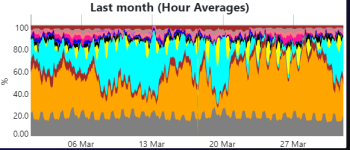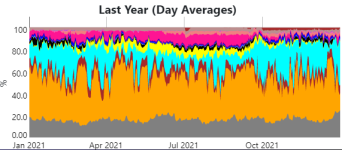For me its quite simple, if the wind supply cannot produce power 24/7/365 and even more so it can move from producing a lot to very little due to sudden changes in wind patterns then its not reliable.
To put in simple terms lets say you need a constantly supply of 1 kiilowatt of power, the wind can produce say 1.5 for 6 hours, and then nothing for the next 10 hours, what happens when it stops, your power cuts off unless you have another source of power.
The expert opinion wouldnt think that because nuclear isnt considered a source of power that is renewable. If the question was 100% reliable energy rather than 100% renewable energy, would those experts think the same thing? There is people who worked on the national grid who have made it clear nuclear was the backbone of cheap power for the country in the past.
Do I want 100% renewable energy? Not at these prices no.
I don't want to sound patronising but you still don't seem to understand that variability doesn't necessarily equate to reliability.
To keep with sour toy example. The 1kw load will be produced form perhaps 20 different windfarms, some producing 5% of the load, some only 1% bug ones maybe 7-10% all with wide geogrpahic seperation. Within each wind farm there are hundred or thousands of individual turbines. The variance on an single turbine is high, but the average variance across the entire system is much lower because there is lwo spatial correlation.
As an example, if you roll a dice there is exactly even odds of landing on any number and it is completely unpredictable. But if you roll 100 dice and take the average, then it will be almost exactly 3.5. The mroe dice you add, the lower the variance in the outcome. This is a fundamental part of statistics called the Central Limit Theorm.
the same applies to wind:
https://en.wikipedia.org/wiki/Greenhouse_Solutions_with_Sustainable_Energy
Graham Sinden from
Oxford University:
[4]
[Graham Sinden] analysed over 30 years of hourly wind speed data from 66 sites spread out over the United Kingdom. He found that the correlation coefficient of wind power fell from 0.6 at 200 km to 0.25 at 600 km separation (a perfect correlation would have a coefficient equal to 1.0.) There were no hours in the data set where wind speed was below the cut-in wind speed of a modern wind turbine throughout the United Kingdom, and low wind speed events affecting more than 90 per cent of the United Kingdom had an average recurrent rate of only one hour per year.
Essentially, the more wind farms we add to the system in different locations, the lower the variance and the more reliable the power generation is.
Going back to your example. The system not only needs to be designed with a distributed installation, but the expected load factors need to be taken into account. Here again we can use historical weather data and climate models to understand probabilities of certain wind conditions occur over periods of time ( i.e, low wind over x days). That is used to design the capacity factor. The szstem wont be designed to peak at 1KW, but will produce at last 1kw in all but the most exceptional periods.
The peek output could be very high, but this is not a problem because wind turbines can be shut off remotely within minutes, and in fact based on forecast can be turned off hours, days or weeks in advance.
And finally the wind output is not considered alone, but in combination with solar, battery storage and potentially gas-peeker plants which could in the future be fom solar genrated hydrogen, cynthesised zero-carbon methane etc.
The system as a whole becomes extremely reliable by design.
This is opposed to reliability problems in nuclear power stations where many of thw problems are inherently unpredictable
https://jpt.spe.org/france-turns-to...f the country's,plants are allowed to operate
France Turns to Coal as Nuclear Plant Shutdowns Threaten Power Grid
France expects to exceed self-imposed limits on coal usage to avoid power outages. This comes as nuclear power plants undergo maintenance and there are not enough renewable energy systems to fill the gap.
Every time there is a slight earthquake, many nuclear power stations have to come offline in France. The maintenance problems are also completely unpredictable , and because the of centrlaized nature are much more problematic than the distributed systems with a 100% renewable energy grid.
For these reason and many others, nuclear simply doesn't have a future. It is the most expensive energy production system known to man, produce huge quantities of radioactive waste that no one knows what to do with and we pay billions and billions every years to store for thousands of years. They take far too long to build, so it is too late for them to have any real part in our energy mix.
There is just so much propaganda out there, like the nonsense that we need nuclear as a base load. That is based on absolutely zero science and makes no logical sense. If 50% of the power comes from nuclear and the rest from renewable, then the renewable aspect is insufficiently diverse to make it reliable and the nuclear will fall far short.
What is needed is the exact opposite if nuclear base base load. 100% renewable power can economically and reliably provide around 90-95% of all power needs, and the more it supplies the more reliable it is. As we approach 100% renewable, costs increase sharply and this is where current renwable technology needs a help hand, to cover that last 5%. This isn't a constant 5%, but a requirement for additional power for a day or 2 at a time a few times a year. Nuclear is by far the worst option for this. Gas peeker is the current best suited current technology. Gas peeker plants can be made to run bio gas, and synthetically generated methane , and in the future solar generated hydrogen.
See thesein depth studies produced by some of the worlds leading independent scientific bodies
https://maps.nrel.gov/la100/#
\
This is why the worlds experts in nuclear energy are actually completely against using nucelar as an approach to zero-carbon.
https://www.theverge.com/2022/1/27/22904943/nuclear-power-climate-change-solution-gregory-jaczko
Former Nuclear Regulatory Commission chair argues nuclear power isn’t a climate solution
‘We have to stop believing the hype’
Former heads of nuclear regulatory bodies across Europe and the US put out a statement this week voicing their opposition to nuclear energy as a climate solution.
Nuclear energy is still
too costly and risky to be a viable clean energy source, the authors of the statement write. They include Gregory Jaczko, former chairman of the US Nuclear Regulatory Commission, and the former leads of similar agencies in Germany, France, and the UK.
I think it’s money that’s not well spent. Nuclear has shown time and time again that it cannot deliver on promises about deployment and costs. And that’s really the most important factor when it comes to climate.
It simply comes down to the need. I do not see a place in which these reactors will play a role because they do not meet the demands of the electricity space right now.
We have to stop believing the hype. Nuclear has never delivered on the hype, and to somehow hinge the future of the planet on unproven design is simply, I think, irresponsible, and we have to recognize that or we’re going to be throwing money at the technologies that are simply never going to deliver.
“NUCLEAR HAS NEVER DELIVERED ON THE HYPE”
The window in which nuclear technology could deliver on a climate pledge closed a year ago or five years ago, realistically. It closed when the V.C. Summer plant decided to shut down. It closed when Vogtle was years and years and years over budget. And everyone has decided to try and knock a hole in the house and try and build a new window.
I taker the opinion of the worlds experts much more seriously than the opinion of forum goers. Nothing personal, but you have shown that you don't really understand reliability of wind and the impacts or variability, and don't understand the costs of nuclear.
I want energy to be reliable, economic and clean. Nucelar doesn't become part of that.




